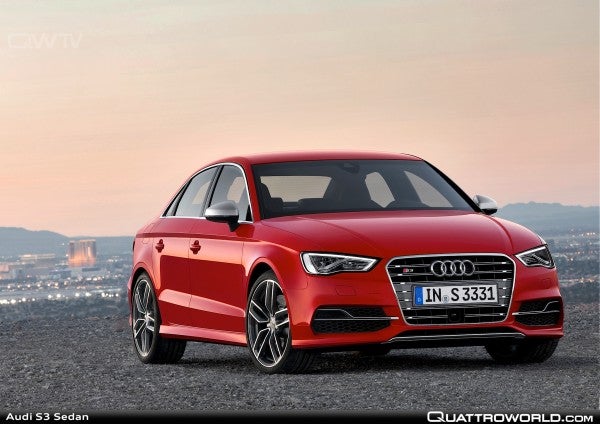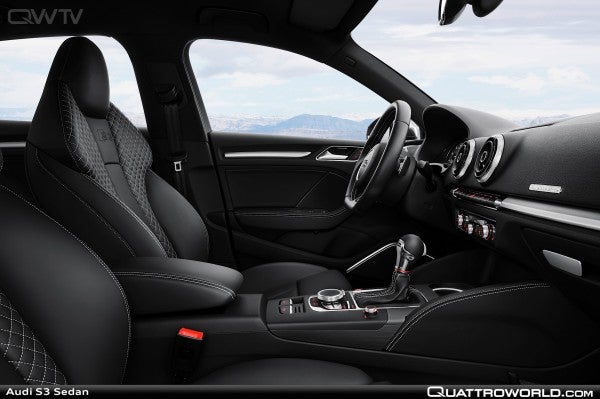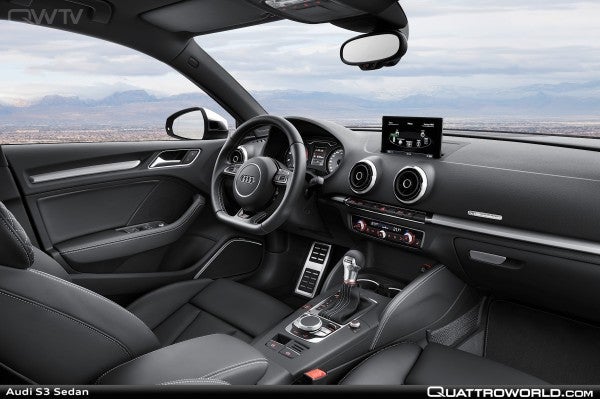
Impressive power and ground breaking efficiency:
The Audi S3 Sedan sets new standards. Its 2.0 TFSI is a
high-output engine, producing 221 kW (300 hp) and 380 Nm (280.27 lb-ft) of
torque, yet consumes on average with S tronic just 6.9 liters of fuel per 100
kilometers (34.09 US mpg). The uncompromising chassis and systematic
lightweight construction underscore the dynamic character of the four-door
model.
The heart of the Audi S3 Sedan is the engine, the 2.0 TFSI
with turbocharging and direct injection. Its predecessor was named
“International Engine of the Year” in its class five times in a row, and the
new 2.0 TFSI boasts even more impressive figures. Its peak output of 221 kW
(300 hp) is available between 5,500 and 6,200 rpm. It delivers a 380 Nm (280.27
lb-ft) of torque to the crankshaft between 1,800 and 5,500 rpm.
Paired with the S tronic, the two-liter engine accelerates
the S3 Sedan from 0 to 100 km/h (62.14 mph) in 4.9 seconds on its way to an
electronically governed top speed of 250 km/h (155.34 mph). In the NEDC, the
four-door sedan with S tronic consumes just 6.9 liters of fuel per 100
kilometers (34.09 US mpg) on average – a CO2 equivalent of 159 grams per
kilometer (255.89 g/mile).
The 2.0 TFSI is a fascinating sport engine and its resonant
sound makes for an intensive experience. When the standard Audi drive select
dynamics system is in dynamic mode, it responds even more directly to
accelerator commands, with brief double-clutching underscoring the change of
gears by the optional S tronic. The sound flaps in the exhaust system open at
higher load and rpm. Two balance shafts ensure tremendous smoothness.
With a bore-to-stroke ratio of 82.5 x 92.8 millimeters (3.25
x 3.65 in), it has a displacement of 1,984 cc. High-load aluminum pistons and
higher-strength connecting rods with new bearings transmit the forces to the
crankshaft. The new aluminum-silicon alloy used for the cylinder head (a new
development compared to the 1.8 TFSI) combines high temperature resistance and
strength with low weight.
The upgraded turbocharger further increases output; it
develops up to 1.2 bar of charge pressure and can withstand exhaust
temperatures of up to 1,000 degrees Celsius. A modified charge air intercooler
lowers the temperature of the compressed air sharply, thus increasing the mass
of air available for combustion. The electronically controlled wastegate valve
operates very quickly and precisely. At part load, it reduces the back pressure
and thus the exhaust pressure resulting in reduced charge-cycles.
The four cylinders are always well filled with the optimum
mixture of fuel and air. “Swumble” flaps (swirl and tumble) induce a targeted
charge motion in the inflowing air – this is the basis for an optimum mixture
preparation. The intake camshaft can be adjusted variably by up to 60 degrees
of crankshaft rotation, the exhaust camshaft by 30 degrees. On the exhaust
side, the Audi valvelift system (AVS) varies valve lift in two stages.
Additional technical features from Audi’s modular efficiency
platform contribute to the low fuel consumption of the 2.0 TFSI. One example is
the additional indirect injection as a supplement to FSI direct injection.
Under part load, this minimises fuel consumption and particulate emissions. FSI
fuel injection comes into play when starting and at higher load.
The innovative thermal management system uses two rotary
valves combined in a single module to regulate coolant flow and temperature.
These valves ensure that the engine oil heats up to its optimum operating
temperature as soon as possible. The exhaust manifold is integrated into the
cylinder head, a further solution that accelerates engine warm-up following a
cold start and lowers the exhaust temperature. Other efficiency measures
include reduced friction by means of an innovative coating for the piston
skirts and roller bearings for the balance shafts, as well as a
demand-controlled oil pump and the start-stop system.
Lightning-fast: The six-speed S tronic
A six-speed manual transmission and the six-speed S tronic
are available. The lower gears of both transmissions are tightly spaced for
sporty performance. The tall ratio of the top gear lowers rpm and thus fuel
consumption. The driver can operate the lightning-fast and nearly imperceptibly
smooth-shifting S tronic in either the D and S automatic modes or manually
using the optional paddles on the steering wheel.
For standing starts, Launch Control (only with S tronic)
delivers the engine’s power to the road with defined tire slip. Another feature
of the dual-clutch transmission is the fuel-saving coasting mode. It is
activated when Audi drive select is set to efficiency and the driver takes his
or her foot off of the accelerator.
The standard quattro permanent all-wheel drive gives the
Audi S3 Sedan the decisive extra when it comes to traction, dynamics and
stability. Its centerpiece is a newly developed, electronically controlled and
hydraulically actuated multi-plate clutch; in order to distribute weight more
efficiently, it is placed in front of the rear differential. The compact and
relatively lightweight clutch distributes the power. Most of it is sent to the
front wheels. If traction decreases there, torque is redirected steplessly to
the rear wheels.
Highly advanced: The chassis
The chassis harmonizes extremely well with the powerful
engine. The Audi S3 Sedan responds to steering input precisely and
spontaneously, taking all types of corners at high speed and with little body
movement.
A key factor is the balanced axle load distribution of 59
percent to 41 percent between the front and rear axles. The 12-degree rearward
inclination of the engine and the front axle located far to the front
contribute to this. Both solutions are part of the Modular Transverse Matrix.
The subframe and pivot bearings of the front suspension are made of aluminum.
The rear axle is a four-link design.
The sport suspension lowers the body of the S3 Sedan by 25
millimeters (0.98 in) compared with the A3 Sedan. The standard feature
progressive steering makes handling even sportier. Its steering rack is
designed so that the steering ratio becomes increasingly direct when turning.
The result is reduced steering effort when parking and when in city traffic.
Steering is extremely precise during fast, sporty driving. Steering boost
varies as a function of speed to ensure excellent steering characteristics for
every driving situation.
The steering works closely together with various assistance
systems on board the new S3 Sedan, such as the standard rest recommendation and
the optional Audi active lane assist and park assist systems.
The new Audi S3 Sedan comes standard with 8 J x 18 wheels in
a five parallel- spoke design. Flow forming technology makes them very
lightweight. The rim well is rolled out under high pressure and at high
temperature. This process strengthens the material, thus permitting thinner
wall thicknesses. 18-inch wheels in a variety of designs are available as
options. 19-inch wheels are also available in combination with the optional
Audi magnetic ride damper control system. 225/40 R18 tires are standard.
With a diameter of 340 millimeters (13.39 in), the front
brake discs are large. Their black (optionally red) calipers bear S3 logos. The
latest evolution of the ESC electronic stabilization control system intercedes
every bit as sportily as sensitively.
Also standard in the Audi S3 Sedan is the Audi drive select
dynamics system, which controls the function of the accelerator, power steering
and the optional S tronic. The driver can switch between the modes comfort,
auto, dynamic, efficiency and individual at the push of a button. The
individual mode allows the driver to specify his own profile of preferred
settings.
Audi drive select also influences the optional Audi magnetic
ride damper control system. Circulating inside the shock absorber pistons is a
synthetic hydrocarbon oil containing tiny magnetic particles. When a voltage is
applied to a coil, a magnetic field is generated in which the particles realign
so that they are oriented perpendicular to the oil flow thereby impeding its
flow in the shock absorber channels.
The system’s controller continuously analyzes the driver’s
style and the condition of the road and adjusts the damping forces within
milliseconds. The driver can choose between three modes. In auto mode, the
dynamic four-door model is very balanced; in comfort mode, relatively soft. In
dynamic mode, however, it assumes a taut stance on the road. The targeted
support of the wheels provides for more neutral self-steering behavior and more
precise steering response.
Aluminum and ultra high-strength steel: The body
The outstanding dynamics of the Audi S3 Sedan are also
attributable to its lightweight construction, one of Audi’s great strengths.
Equipped with the manual transmission, the four-door model has a curb weight
(without driver) of just
1,430 kilograms (3,152.61 lb). Ultra high-strength steels are used in many
areas of the occupant cell; the engine hood is made of aluminum.
The Audi S3 Sedan also expresses its dynamic nature
visually, with an athletic design and a decisive look. The flat engine hood,
the precisely drawn lines, the tautly curved surfaces and the flat roof arch
stretch the body visually. The new top-of-the-line model is 4,469 millimeters
(14.66 ft) long, 1,796 millimeters (5.80 ft) wide and 1,392 millimeters (4.57
ft) tall. The long wheelbase of 2,631 millimeters (8.63 ft) provides for a
generously spacious interior.
Specific details underscore the high-performance character
of the Audi S3 Sedan. The S-specific Singleframe grille has aluminum-look,
double horizontal bars. A chrome frame surrounds the grille; the insert is
finished in matt platinum gray. Aluminum-look double ribs and honeycomb inserts
fill the air inlets in the bumper, which are framed with strongly flared edges.
Audi offers optional LED headlights for excellent illumination of the road and
an unmistakable look.
Aluminum-look exterior mirror housings and the sill strips
catch the eye on the flanks of the four-door sedan. The rear bumper has been
redesigned, and a subtle spoiler lip provides an aesthetic design feature at
the top of the trunk lid. The rear lights predominantly employ LED technology.
The platinum gray diffuser has an aluminum-look double bar and four ribs. It
encloses the exhaust system’s four oval tailpipes with their chrome tips. Among
the twelve paint finishes are the exclusive crystal-effect colors Panther black
and Sepang blue. S3 badges adorn the rear and the front.
Entirely in black: The interior
The Audi S3 Sedan features an all-black interior, including
the standard inlays in matt brushed aluminum. Many of the controls shine in an
aluminum-look finish. As in every Audi, operation is simple and the quality
uncompromising. The luggage compartment holds 390 liters (13.77 cubic ft).
Great attention to detail documents the sedan’s dynamic
character. The dials of the instruments are in an S-specific dark gray metallic
finish; the numbers and needles are white. The tachometer features a
three-dimensional S3 logo and a boost pressure indicator. A color driver
information system with lap timer is standard. The power-retractable monitor
(standard with the MMI radio and above) powers up to display a special S3
screen.
A leather-covered sport steering wheel with an S3 badge is
also standard in the Audi S3 Sedan. Audi also offers a leather-covered,
multifunction sport steering wheel with the rim flattened at the bottom, and
shift paddles with aluminum details are available as an option in combination
with the S tronic. Other S-specific features are the pedals and footrest of
brushed stainless steel as well as the red rings on the start-stop button and
on the specially designed gear selector lever. The aluminum door sill trims
with S3 badge round out the high-quality and exclusive package.
The front sport seats provide optimum hold and support. The
seat cushions can be extended, and S3 logos are embossed in the backrests. The
side bolsters come as standard covered in Pearl Nappa leather while the seat
center sections are covered in cloth. Combinations of Alcantara and Pearl Nappa
leather or Fine Nappa leather with Velvet leather are also available. Contrast
stitching provides accents. Audi offers optional S sport seats with integrated
head restraints and shoulder inserts with diamond quilting. The two-colour Audi
design selection in black/parade red is an exclusive alternative.
by James




















